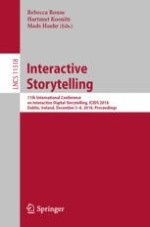2018 | OriginalPaper | Chapter
Predictability and Plausibility in Interactive Narrative Constructs: A Case for an ERP Study
Authors : Bjørn Anker Gjøl, Niels Valentin Jørgensen, Mathias Ramsø Thomsen, Luis Emilio Bruni
Published in: Interactive Storytelling
Publisher: Springer International Publishing
Activate our intelligent search to find suitable subject content or patents.
Select sections of text to find matching patents with Artificial Intelligence. powered by
Select sections of text to find additional relevant content using AI-assisted search. powered by
